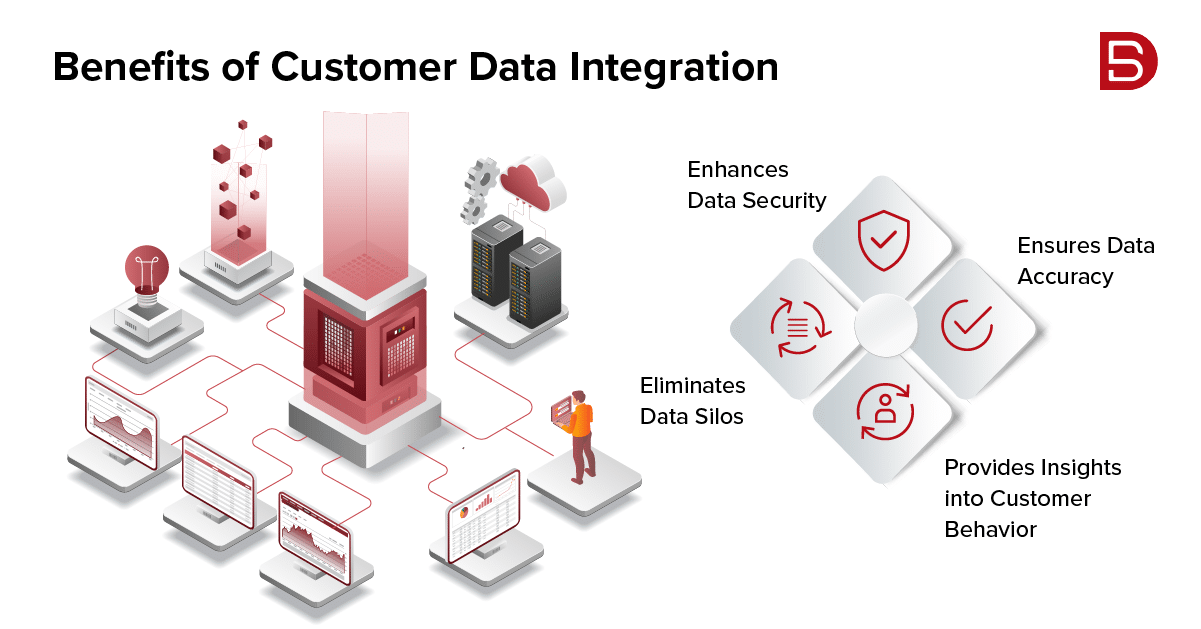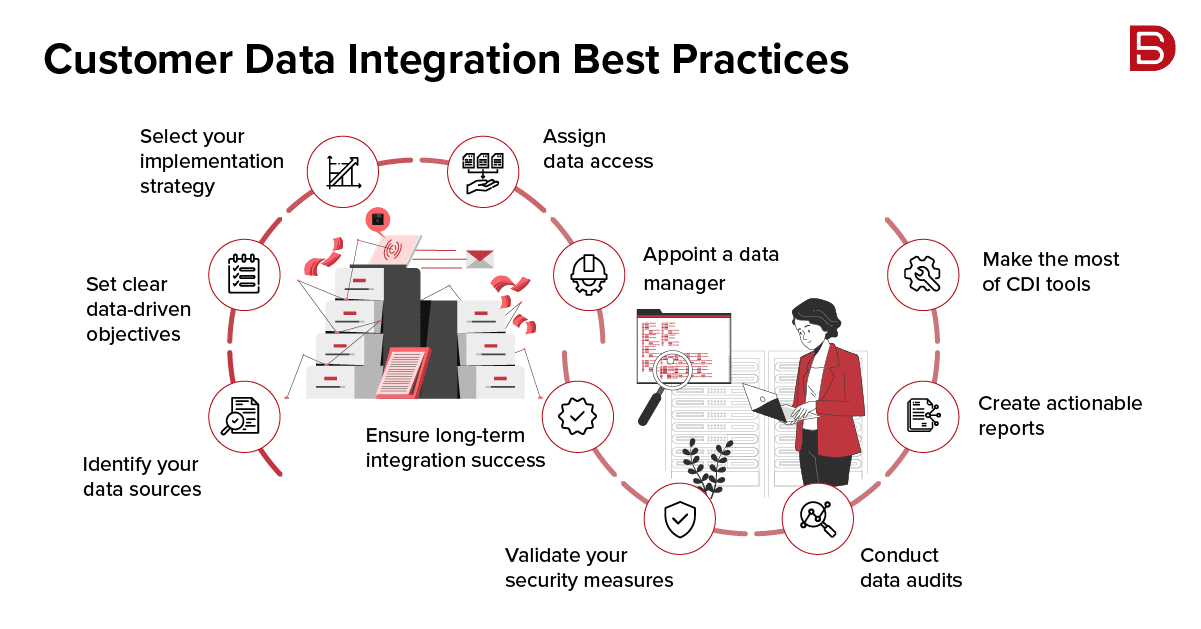According to a recent study by Report Linker, the global data integration market is on a notable upward trajectory. Projections suggest a substantial growth, surging from $12.14 billion in 2022 to an anticipated $19.09 billion by 2026.
Safe to say, navigating this data-rich environment poses a challenge for B2B companies, as they strive to convert diverse data from communication channels into customer-focused insights. Enter Customer Data Integration (CDI), a key solution bridging the gap, empowering businesses to transform data into tailored strategies for enhanced outcomes.
As per a McKinsey analysis, B2B companies leveraging data analytics for enhanced marketing and sales performance stand a 1.5-fold higher chance of surpassing their competitors in growth rates.
Despite this potential, many marketers face challenges in optimizing the value of gathered client data. According to the Salesforce State of Sales Report, a significant 72% of B2B sales representatives admit to struggling with data interpretation. A major contributing factor is the difficulty in obtaining a clear view of all the accumulated customer-based data.
CDI empowers businesses to consolidate their diverse data into a unified source. This allows each team member seamless access, enabling them to filter information based on their specific interests. Keep reading for deeper insights into CDI and simplified implementation strategies.
What is Customer Data Integration?
It is the process of consolidating, merging, and managing customer-based data gathered from diverse sources across all business systems into a cohesive, unified view.
By achieving this comprehensive perspective of customer data, a company gains a deeper understanding of the customer experience within its pipelines. This consolidated view facilitates insightful information that can significantly enhance operations across all departments.
Within the CDI framework, you find information accessible through direct marketing encounters, consumer valuation data, contact details, and more. Beyond its organizational benefits, this single view also plays a crucial role in ensuring secure maintenance of client data, aiding companies in compliance with various data protection standards such as GDPR and CCPA.
The main objective of customer data integration is to provide businesses with a unified view of all their customer-based data on a single screen. For teams overseeing B2B sales and marketing, this consolidated “golden record” becomes a valuable tool to focus efforts on the most lucrative prospects. This not only streamlines processes but also leads to significant cost and time savings.
Role of Customer Data Integration in Business Growth
Embracing customer integration yields numerous advantages. By amalgamating B2B data from diverse sources, businesses can enhance customer satisfaction through tailored products, services, and marketing messages that cater to the unique demands of each individual customer.
Here are the top four benefits of incorporating customer data integration techniques into your company:
1. Eliminates Data Silos
Data silos, where information is confined to a specific department and isolated from the rest of the business, can hinder operational efficiency. Often, these silos unintentionally form when departments utilize specialized tools, systems, and procedures. By implementing best practices in CDI, B2B businesses can break down these silos, gaining a comprehensive view of audience data collected by each business unit.
This enables the identification of successful campaigns, communications, and triggers that attract high-value clients, while pinpointing areas that may be falling short of expectations through consolidated data insights from all active departments.
2. Enhances Data Security
Centralizing data access through a single point of oversight by organizational decision-makers bolsters the confidentiality of consumer data. While consolidating all customer data into one location, a customer integration platform empowers data managers to regulate how each team member utilizes this information.
This approach ensures that every employee has access only to the information necessary for their regular tasks. Moreover, it simplifies the process of granting or revoking data-analytics privileges for employees entering or leaving the business, all without compromising the security of confidential data.
3. Ensures Data Accuracy
The success of any data-driven lead generation campaign hinges on the accuracy of the data. Thanks to CDI strategies employed by B2B marketing and sales teams, effective data segmentation becomes a reality. This involves refining the target market using characteristics like industry, budget, region, and technology usage, all while ensuring that prospect information undergoes regular updates.
The absence of a customer integration plan exposes businesses to the risk of data decay. This decay results in a decline in B2B database quality, leaving Sales Development Representatives (SDRs) grappling with outdated, erroneous, or incomplete client information. Not only does this complicate their tasks, but it also hampers overall efficiency. You can always partner with a B2B data provider to safeguard against data decay while propelling your campaigns with a strategic advantage.
4. Provides Insights into Customer Behavior
With a well-structured, data-driven framework for analyzing the target audience, marketers and sales professionals can discover new ways to engage prospects based on successful past situations. B2B organizations can leverage CDI to identify ideal customer profiles (ICPs), extract target account lists from prospect records, and predict success in prospecting campaigns by combining relevant elements.
Ways to Integrate Customer Data
There are different methods for CDI, and the right one for your business depends on the amount of data, database organization, and the platforms used. Here are three primary ways to integrate data records:
1. Data Consolidation
The most efficient form of data integration is data consolidation, where multiple information sources are merged into a single data warehouse. A CDI tool can automate the extraction and transfer of data from one platform to another, enhancing the value of data integration through standardization.
2. Data Propagation
Data propagation involves creating a copy from a dataset, ensuring that while it becomes accessible in a different location, the original data remains in its source. This can be useful for businesses aiming to have two separate lead generation systems focusing on different stages of the cycle while utilizing the same data. However, it’s essential to be cautious, as this approach may lead to the development of data silos, potentially impacting critical insights.
3. Data federation
This approach seems akin to data consolidation. Data federation enables users to have a unified view of all available data. The key difference lies in data federation maintaining the separation of data sources, posing challenges in terms of analysis, control, and comprehensive modification of information.
Top 10 Best Practices for Customer Data Integration
With new client data continuously entering sales pipelines, CDI should be seen as an ongoing process that requires a robust framework to effectively organize and present all necessary data. To maximize the potential of this methodology, your team can greatly benefit from the following CDI best practices:
1. Identify Your Data Sources
Every interaction with clients adds a piece to the prospect profiling puzzle. Valuable consumer information can be found in email responses, transactions, content evaluations, completed forms, and direct messaging. Though not all sources are equally important, combining them helps marketers create effective buyer personas and ICPs.
2. Set Clear Data-Driven Objectives
Consider data as a valuable resource that needs direction. Without precise goals for your organization’s CDI efforts, the abundance of data may become overwhelming, hindering the extraction of meaningful insights. Clearly defining short and long-term objectives is like establishing dams to control and utilize your data stream effectively.
3. Select Your Implementation Strategy
Effective CDI systems rely on well-defined rules and processes. The decision regarding data distribution, whether it’s federation, propagation, or consolidation, holds significant consequences. Once a path is chosen, reverting is often a costly and time-consuming endeavor.
4. Assign Data Access
Identify which team members have access to specific databases, a crucial step in streamlining your data management. After consolidating all client data in your warehouse, incorporate categories and filters to empower users in efficiently managing their desired data.
5. Appoint a Data Manager
The data manager, not necessarily a C-level executive, plays a crucial role in safeguarding your client database. Responsible for approving and rejecting access, the ideal candidate should have a close association with the organization and strong data management abilities.
6. Ensure Long-Term Integration Success
Strategize your CDI approach with the future in mind. While swift decisions are crucial for immediate actions, planning for long-term success involves integrating more data to yield sound and profitable outcomes. Starting with advanced tools, rules, and configurations that can be easily adjusted makes practical sense for future-proofing your integration.
7. Validate your security measures
Even with CDI technologies streamlining access to all customer data, it’s vital to set up security locks during installation. Grant access only to authorized personnel responsible for the most sensitive data to prevent any potential breaches or leaks, ensuring robust protection.
8. Conduct Data Audits
For genuine insights, it’s crucial to routinely validate the accuracy of your databases. Consistently analyzing both new and existing data ensures your team operates with up-to-date knowledge consistently.
9. Create Actionable Reports
Now that your customer data is up and running, make the most of it. Bring together pipeline expansion managers to identify the reports necessary for strengthening strategies, exploring new market opportunities, and validating the success of initiatives.
10. Make the Most of CDI Tools
Streamline the collection, integration, and distribution of consumer data with a CDI platform. Configure these tools to automatically conduct ongoing audits for each data warehouse, removing duplicates and outdated records. They also simplify data management by categorizing information for individual users, offering a clear view of all client details necessary for their daily tasks.
Conclusion
Effective data integration stands as a pivotal stride toward transforming your organization into a data-driven powerhouse. Without it, you’re left with scattered data silos, hindering a comprehensive understanding of your customers.
To address this, we offer seamless native integrations of B2B databases with top platforms like Salesforce, Oracle, Outreach, Salesloft, and more. This integration extends beyond mere connectivity, streamlining data operations for a holistic view that empowers data-driven marketing. Reach out at marketing@datamaticsbpm.com and let’s unlock the full potential of your B2B data together.
 Select an element to maximize. Press ESC to cancel.
Select an element to maximize. Press ESC to cancel.
James Libera




